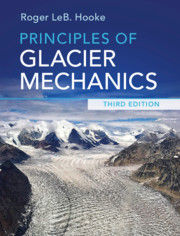Book contents
- Principles of Glacier Mechanics
- Reviews
- Principles of Glacier Mechanics
- Copyright page
- Dedication
- Contents
- Preface to the third edition
- Preface to the second edition
- Preface to the first edition
- Physical constants relevant to ice
- Derived SI units and conversion factors
- 1 Why study glaciers?
- 2 Some basic concepts
- 3 Mass balance
- 4 Flow and fracture of a crystalline material
- 5 The velocity field in a glacier
- 6 Temperature distribution in polar ice sheets
- 7 The coupling between a glacier and its bed
- 8 Water flow in and under glaciers: Geomorphic implications
- 9 Stress and deformation
- 10 Stress and velocity distribution in an idealized glacier
- 11 Numerical modeling
- 12 Applications of stress and deformation principles to classical problems
- 13 Ice streams and ice shelves
- 14 Finite strain and the origin of foliation
- 15 Response of glaciers to climate change
- 16 Ice core studies
- Problems
- References
- Index
6 - Temperature distribution in polar ice sheets
Published online by Cambridge University Press: 20 December 2019
- Principles of Glacier Mechanics
- Reviews
- Principles of Glacier Mechanics
- Copyright page
- Dedication
- Contents
- Preface to the third edition
- Preface to the second edition
- Preface to the first edition
- Physical constants relevant to ice
- Derived SI units and conversion factors
- 1 Why study glaciers?
- 2 Some basic concepts
- 3 Mass balance
- 4 Flow and fracture of a crystalline material
- 5 The velocity field in a glacier
- 6 Temperature distribution in polar ice sheets
- 7 The coupling between a glacier and its bed
- 8 Water flow in and under glaciers: Geomorphic implications
- 9 Stress and deformation
- 10 Stress and velocity distribution in an idealized glacier
- 11 Numerical modeling
- 12 Applications of stress and deformation principles to classical problems
- 13 Ice streams and ice shelves
- 14 Finite strain and the origin of foliation
- 15 Response of glaciers to climate change
- 16 Ice core studies
- Problems
- References
- Index
Summary
In this chapter the energy balance equation is derived and temperature-depth profiles are calculated at an ice divide and some distance from the divide. The mean annual temperature at the surface and either the temperature gradient or the pressure melting point at the bed, as appropriate, are used as boundary conditions. In both solutions the vertical velocity is assumed to decrease linearly with depth, and longitudinal advection is approximated by assuming a warming rate at depth equal to that at the surface. Both lead to basal temperatures that are too cold, but with suitable caution the models are useful for illustrating how various physical processes that affect the temperature distribution are reflected in calculated temperatures along a flowline. Numerical models incorporating more variables can be used to extract estimates of temporal changes in surface temperature and ice sheet thickness from measured temperature profiles. Finally, we discussed some geomorphic features formed at boundaries between zones of thawed and frozen bed, like hill-hole pairs and some types of ribbed moraine, and noted that they can be used to constrain numerical models of ice sheets.
Keywords
Information
- Type
- Chapter
- Information
- Principles of Glacier Mechanics , pp. 115 - 148Publisher: Cambridge University PressPrint publication year: 2019
